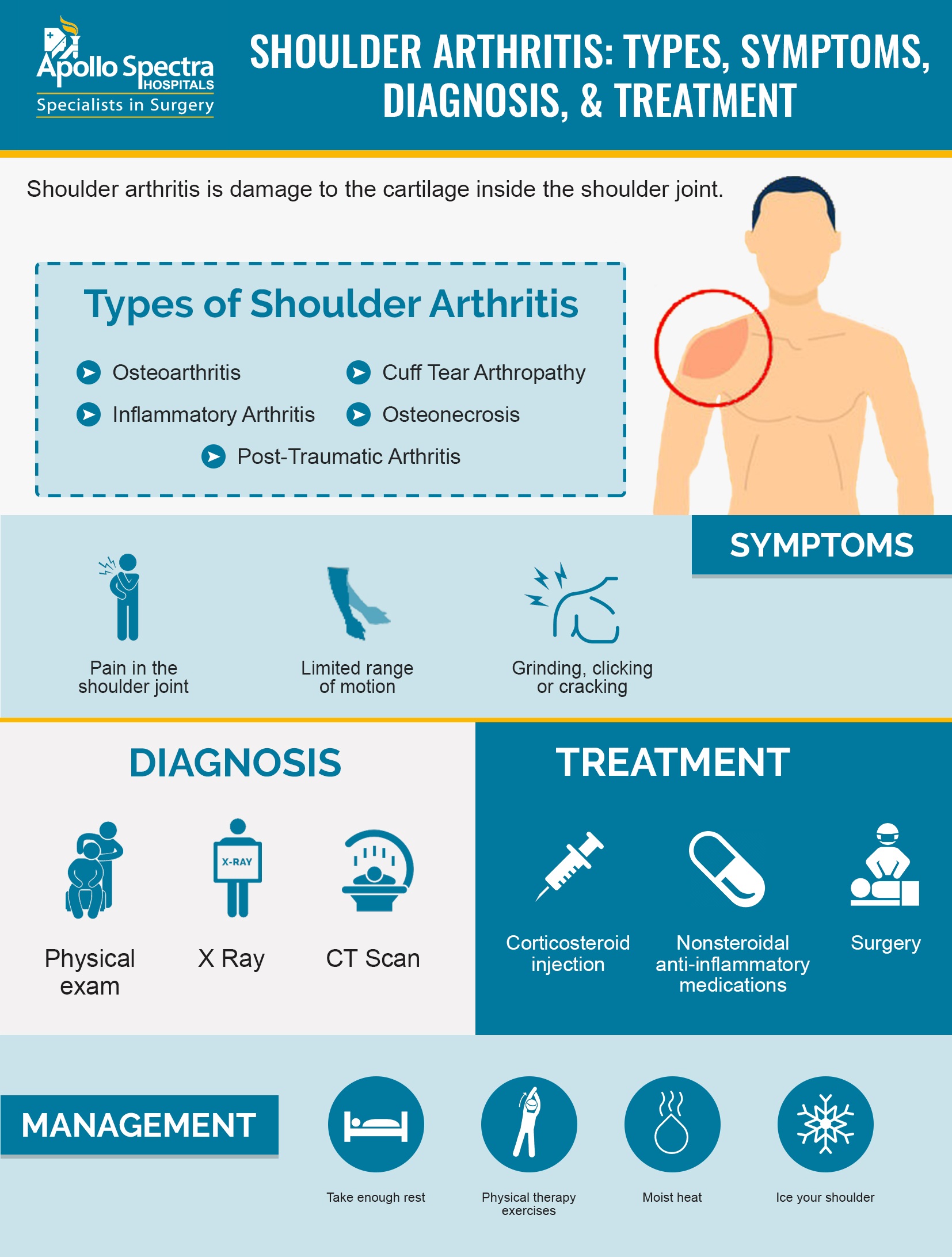Symptoms of Shoulder Arthritis
March 30, 2020

The shoulder joint is basically a ball-and-socket joint located at the junction of the thorax and the arm. A part of the shoulder blade forms the socket of the joint while the top of the arm forms the ball of the joint. The shoulder joint moves more than all other joints in the body. However, it can cause pain and even disability if the joint becomes arthritic.
Shoulder arthritis is caused as the cartilage in the shoulder breaks down, starting from the surface and then moving on to the deeper layers. Arthritis may also develop in another joint in the shoulder, known as AC or acromioclavicular joint. This is called AC joint arthritis.
The most common kind of shoulder arthritis is osteoarthritis. It is also known as degenerative joint disease or wear-and-tear arthritis. This condition is characterized by the cartilage of the shoulder joint wearing away progressively. Wearing away of the protective cartilage surface of the joint exposes the bare bone within the shoulder.
Rheumatoid arthritis is another common type of arthritis of the shoulder. It is a systemic autoimmune condition causing the tissue surrounding the joint to inflame. Over time, this inflammation can damage the bone and cartilage.
Generally, people over the age of 50 are affected by shoulder arthritis. The condition tends to be more common among people having serious shoulder injuries or having a history of a previous shoulder injury and surgery. Shoulder arthritis, particularly rheumatoid arthritis, has a genetic predisposition. This means the condition has a tendency of running in families.
How does shoulder arthritis develop?
The cartilage gradually wearing and tearing is the usual cause of shoulder arthritis. Every joint in the body has cartilage covering the surface of the bones within the joints. The cartilage is responsible for softening the contact between bones. It is a living tissue around 2 mm - 3 mm thick. Intact cartilage allows for smooth rotation, meaning there is no wear despite multiple rotations.
Usually, shoulder arthritis starts developing in stages. It starts with the cartilage getting soft, followed by cracks being developed on the surface. Then, the cartilage starts deteriorating and flaking, or fibrillating. Finally, the cartilage wears away, exposing the bone surface. This results in the cartilage failing to act as a smooth surface for the bones to move.
Wearing away the cartilage doesn’t occur all at once over the whole surface of the bone. Actually, wearing away occurs at varying rates in different parts. The cartilage usually undergoes more damage after the surface gets irregular. It may start thinning out and eventually resulting in the bones of the shoulder rubbing with one another. A lot of people consider arthritis to be a condition of traction between bones. However, arthritis is actually a condition that eventually leads to traction between bones in joints.
Shoulder arthritis does get worse but it is not possible to determine how rapidly it will do so. In each individual case, the degree of damage that the cartilage has suffered tends to differ. Usually, if specific activities cause pain, it is an indication of stress to the cartilage. In general, if the activity is more painful, it is likely to cause damage to the shoulder joint and cartilage.
Symptoms of shoulder arthritis
The symptoms associated with shoulder arthritis have a tendency of worsening as the condition continues to progress. Interestingly, the symptoms of the condition won't always progress in a steady manner over time. It is common for affected individuals to experience better or worse symptoms in different months or different weather conditions. This is particularly important since the symptoms of shoulder arthritis on a specific day may not be an accurate representation of how far the condition has progressed.
The most common symptoms associated with the condition include:
- Pain while performing activities
- Reduced range of motion
- Swelling of the joint
- Stiffness of the shoulder
- A feeling of catching or grinding in the shoulder joint
- Tenderness around the shoulder joint
Evaluating an individual who may have shoulder arthritis starts with a physical exam and imaging scans like X-rays. This serves as the baseline for determining how far the condition progresses in future and evaluating later examinations.
NOTICE BOARD
CONTACT US
CONTACT US
 Book Appointment
Book Appointment


.svg)
.svg)
.svg)
.svg)








